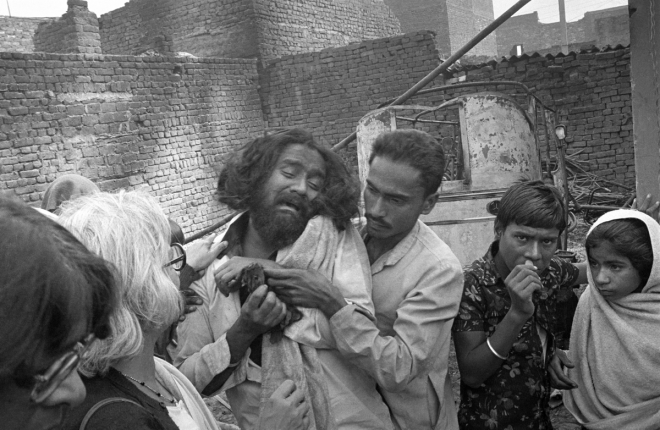The torture faced by Sikhs in 1984 finds no mention in global history. Had the community received justice against the state-sponsored act of terrorism against them, it wouldn’t have set a precedent for Gujarat riots in 2002. Those who forget history are bound to repeat it.

Image Courtesy: Ram Rahman
When I was reading a magazine on Nelson Mandela this summer, something caught my attention.
The mention of how some anti-apartheid activists killed collaborators by using burning tyres as necklaces filled with petrol and then setting them on fire which caused worldwide outrage, made me curious.
I ran my search engine to find more about this practice of killing people in Africa.
My interest in the subject despite its goriness was triggered by the fact that this technique was once applied to my own community back in 1984. That prompted me to do a little research on the term ‘Necklacing’ which is often used to describe this brutal method of killing people.
As I hit Wikipedia, I was disappointed to find that this fact was simply overlooked. The Wikipedia definition did touch upon necklacing having been used in Sri Lanka in 1960 by Sinhala chauvinists against Tamils, but then straightaway, ran over to South Africa.
Quoting a Truth and Reconciliation Commission, it claimed that the first victim of necklacing in South Africa was killed in 1985 and even stated that it was used by the “black community to punish its members who were perceived as collaborators with the apartheid government.”
The Wikipedia information glossed over the necklacing of scores of Sikhs in India following the assassination of Prime Minister Indira Gandhi by her Sikh bodyguards on October 31, 1984.
The mobs, instigated by the slain leader’s Congress party, had targeted innocent Sikhs across the country with the help of police. That the tyres and kerosene were supplied to the mobs by the Congress party leaders to punish the entire community is well documented.
It is also important to mention that many world leaders also attended the cremation of Indira Gandhi in New Delhi, while the bloodshed continued for several days. It, therefore, is difficult to believe that Wikipedia could miss such an important chapter in world history.
This forced me to sign up with Wikipedia and add this information. Though I achieved what I wanted through this simple action, this leaves me with a much broader question that how much does the world really know or care about the anti-Sikh massacre? Most people do know India as the world’s largest secular democracy, but they probably need to be told about the darker side of this giant nation as well. This becomes essential because the victims of 1984 continue to wait for justice. Just because Sikhs form merely two per cent of the Indian population does not mean that their story can be ignored. There needs to be an acceptance of the Sikh massacre as a state-sponsored act of terrorism. If the Indian legal justice system has failed the victims, it becomes necessary for the global community to intervene.
Also, the way necklacing is being squarely blamed on the black community is itself problematic and racist. These kinds of framings show the anti-apartheid struggle in a bad light and is an unfair portrayal of the black people. One can agree that there were some anarchists within the anti-apartheid movement, who not only indulged in these violent acts but also condoned it. However, one cannot make a sweeping statement against the whole black community. It’s a shame that a genuine struggle against apartheid has been allowed to be demonized with such framings because of the acts of few individuals. Whereas similar acts of violence against innocent Sikh civilians by the custodians of the Indian state were completely ignored. This hypocrisy is also troublesome because the Indian state, in spite of its own internal contradictions and barbaric character, tried to project itself as an ally of South African people fighting against the apartheid rule.
The Sikh Diaspora have made limited success in raising cross-sectional awareness on this issue and have roped in support of individual politicians worldwide through initiatives such as the annual blood drive in Canada which has saved 1,30,000 lives. They have filed petitions asking to recognize the massacre as Sikh Genocide but the world leaders and international bodies have yet to acknowledge it officially.
This is not to suggest that the Sikhs alone are being persecuted in India. Under the current right-wing Hindu nationalist BJP government, all minorities are being targeted systematically. And yet, there is a deafening silence about it in the west which is too enamoured by Indian democracy and their trade interests with the Indian government.
After all, the present Indian Prime Minister Narendra Modi was also complicit in a similar pogrom directed against Muslims in Gujarat in 2002. More than 50 people had died when a train carrying Hindu pilgrims caught fire in Gujarat. The incident was blamed on Muslim fundamentalists by the BJP government in the state, following which scores of innocent Muslims were murdered by the Hindu extremists. 1984 was repeated in Gujarat when Modi was the Chief Minister of the state.
It is believed that, had justice been served to the Sikhs, the Gujarat pogrom wouldn’t have happened. The Sikh massacre had set a precedent of impunity for those indulging in mass murders, to make scapegoats of minority communities and retain power in the name of faith and identity.